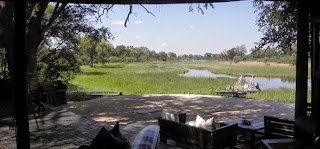Late rains and eco-tourism
After a particularly dry start to the year, unusually heavy late rains at Easter have transformed Botswana into a verdant paradise. With plentiful water and good grazing across a vast area, game has dispersed widely, making it sometimes hard to see. But the overwhelming sense of contentment and plenty, with species grazing alongside each other in sunlit glades, makes it an uplifting experience. For the time being, even the Kalahari is green; grazed by zebra and wildebeest as far as the eye can see.
 |
| Giraffe at Selinda Explorer Camp, April 2015 |
Botswana's greenness is, however, not limited to the vagaries of unpredictable weather patterns. In this country, greenness goes much deeper. Traditionally Botswana was sustained by beef, diamonds and hunting but for many years and particularly since the total ban on killing game for sport, eco-tourism has replaced hunting as a major source of income.
As a country, Botswana has an area roughly the size of France and a population of only 2.1 million people. So exclusivity is the key to its low volume / high value tourism model. Essentially, the government owns the land, granting concession areas to private companies on fifteen year leases.
 |
| Motswiri Camp, April 2015 |
Yet, the Botswana authorities retain a degree of control, monitoring the environmental impact of camps and operations, advising on changes of sites if existing sites have adversely impacted the area in which they operate. Those who hold leases for the concessions are willing partners in the drive to sustainable eco-tourism because it is Botswana’s stability and green credentials that help to make it such a desirable tourist destination.
In line with this green approach, the generators that power camps are increasingly being replaced with renewable energy sources, with many lodges and camps now having solar installations on site as well as small scale solar farms for additional power. Solar lights and electricity produced by food waste are being explored and hybrid electric vehicles may be seen in some areas in the near future.
In line with this green approach, the generators that power camps are increasingly being replaced with renewable energy sources, with many lodges and camps now having solar installations on site as well as small scale solar farms for additional power. Solar lights and electricity produced by food waste are being explored and hybrid electric vehicles may be seen in some areas in the near future.
 |
| DamaTau Camp, Linyanti Reserve |
In keeping with the high value tourist market, visitors’ comfort is in no way compromised and camps and lodges remain top of the range with safety and creature comforts in abundance. For many, however, the green experience is additionally enhanced by lack of phone reception or internet availability, making reading and talking round the bar or camp fire accompanied by the sounds of nature the norm.
As the season advances, the lush greenness of April and May will give way to vast parched areas of tinder dry vegetation, concentrating game increasingly to areas with access to water. But while the background colour changes, Botswana’s tourist industry will remain resolutely green.
For more details about planning a trip with Bushbuck Safaris see www.bushbucksafaris.com
 |
| Okovango Delta, April 2015 |

No comments:
Post a Comment